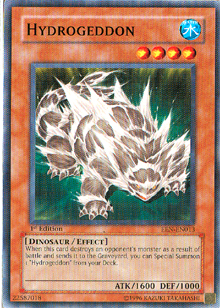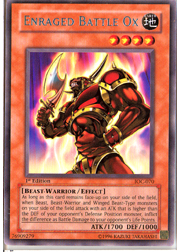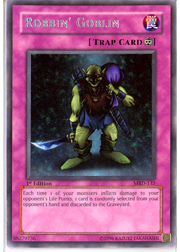
Hydrogeddon entered this format as a defining card, and the fast tempos it created in conjunction with Cyber Dragon really set the pace back in September. It continued to be a format-shaping force as the months wore on, vaulting Creature Swap/Asura Priest decks to success in its wake and terrifying Treeborn Frog cards the world over.
Several factors have slowed the popularity of Hydrogeddon over the past couple of months. Players just got better at dealing with it, learning to draw out Hydrogeddon plays and manage them in controlled situations, or keeping removal traps on hand to shut the first Hydro down right off the bat. It became a more popular target for Confiscation, and the upswing in Enemy Controller usage was another black mark on Hydro’s future. For about eight weeks, the little explosive Dinosaur-that-could seemed to be lying low.
 The release of Machine Re-Volt has changed all that! While Hydrogeddon is certainly a high-risk tech card to take against Gadgets (a single Sakuretsu Armor often leaves the Hydrogeddon player in a terrible situation), the reward is certainly tempting. Turning your opponent’s two or three Gadgets into graveyard fodder while filling your field for free is just too good to resist, and Hydrogeddon has seen a resurgence in a lot of North American metagames. Today’s contributor takes the high-impact Dino to new heights—making it hit even harder—so check out what he had to say about it.
The release of Machine Re-Volt has changed all that! While Hydrogeddon is certainly a high-risk tech card to take against Gadgets (a single Sakuretsu Armor often leaves the Hydrogeddon player in a terrible situation), the reward is certainly tempting. Turning your opponent’s two or three Gadgets into graveyard fodder while filling your field for free is just too good to resist, and Hydrogeddon has seen a resurgence in a lot of North American metagames. Today’s contributor takes the high-impact Dino to new heights—making it hit even harder—so check out what he had to say about it.
I made this deck a while back and I wanted to make it better. It uses Hydrogeddon, piercing attackers, and high-DEF monsters to trigger Robbin’ Goblin, and it can really tear apart an unprepared opponent. I am considering Brain Control: though the deck works, it can be pretty slow at times.
—Nonya N.
Here’s what Nonya’s deck looks like:
Robbin’ Hydro—40 Cards
Monsters: 24
3 Mobius the Frost Monarch
3 Cyber Dragon
3 Legendary Jujitsu Master
3 Gravekeeper's Spy
3 Dekoichi the Battlechanted Locomotive
3 Hydrogeddon
3 Gravekeeper's Spear Soldier
1 Sangan
1 Breaker the Magical Warrior
1 Spirit Reaper
Spells: 8
3 Smashing Ground
1 Book of Moon
1 Nobleman of Crossout
1 Heavy Storm
1 Graceful Charity
1 Pot of Avarice
Traps: 8
3 Robbin' Goblin
3 Sakuretsu Armor
1 Ring of Destruction
1 Mirror Force
The build is really solid! While Gravekeeper’s Spy is popular Gadget tech right now, you don’t see many players running more than two and then rolling that special summoning potential into Gravekeeper’s Spear Soldier, which is really a potent idea. Like Nonya mentioned, the deck can use high DEF, swarming attackers, and piercing damage to get Robbin’ Goblin to work, and creating big disparities in hand presence is only amplified when this deck special summons a Spy or Hydro.
The deck looks good, so I actually built it and tested it. I found that games where I managed to spin a monster or two with Legendary Jujitsu Master, and then drew and used a couple of pieces of monster removal, tended to go well. However, I did have several games that just went too slowly and passively. My Jujitsu Masters and Spies would sit on the field stalling for a bit, but would quickly succumb to Cyber Dragon or worse yet, Jinzo. If I couldn’t get enough removal going, my opponent could wait me out and drop a couple of big monsters that I wouldn’t be able to deal with, and that was responsible for the bulk of my losses. The deck just wasn’t capable of putting forth enough pressure to keep the opponent on the ropes, and I don’t even want to talk about the Chimeratech Overdragon matchup. Again, the deck just wasn’t quite fast or aggressive enough, and I don’t think that swiping a monster for one turn with Brain Control is going to do the trick.
The good news is that we can fix that.
Nonya’s dedication to his central strategy is evident in the number of cards he maxes out on, and normally my advice in deckbuilding includes the words “tighten up your focus.” A deck doesn’t need to do everything in order to win: it just needs to do a few things very well. So it feels strange, but I’m actually going to diversify Nonya’s cards a bit. I’ll also be replacing the Gravekeeper’s Spear Soldier cards with something a bit beefier, because ironically, the Soldiers themselves get victimized by an opposing Hydrogeddon. Since Hydro is regaining popularity in leaps and bounds, we can’t have that.
So the first drop is all three Spear Soldiers. I wince as I do it, because I love the idea of searching a Soldier with Gravekeeper’s Spy, but the deck’s average ATK just isn’t high enough. I’ll drop the third Spy as a direct result, making the deck a little less innovative but leaving side decking options open: you can always rotate in the third Spy and all three Spear Soldiers for a matchup that allows it.
One Legendary Jujitsu Master and one Dekoichi the Battlechanted Locomotive will also be dropped. These are both powerful defensive cards, but again, they just don’t have the offensive capabilities we’re looking for. This reduction in defensive monsters that can maintain field presence or create easy tribute bait will also make Mobius the Frost Monarch a bit tougher to use, so I’ll drop the deck’s Mobius count down to two.
 I’ve dropped seven cards from the deck, and the first thing I want to do is add some bigger bodies. This isn’t really a tough choice: Enraged Battle Ox fills in for Gravekeeper’s Spear Soldier thanks to an additional 200 ATK. We lose the cool special summoning tricks, but we also cast aside the vulnerability to Hydrogeddon, and the potential to lose our complete field to an Asura Priest that then scampers back to its controller’s hand.
I’ve dropped seven cards from the deck, and the first thing I want to do is add some bigger bodies. This isn’t really a tough choice: Enraged Battle Ox fills in for Gravekeeper’s Spear Soldier thanks to an additional 200 ATK. We lose the cool special summoning tricks, but we also cast aside the vulnerability to Hydrogeddon, and the potential to lose our complete field to an Asura Priest that then scampers back to its controller’s hand.
Perhaps the most important change I want to make is adding Confiscation. I’m a big believer that whenever you build a deck, you should immediately be considering this card. With Cyber-Stein gone, there just aren’t that many reasons not to use a spell that lets you see your opponent’s hand and then eliminate his or her best card. For this strategy, though, there are actually several specific reasons to run it beyond those you’d normally expect. Being able to keep Jinzo off the field is necessary to keep your central plan alive, because if your opponent manages to summon him, you’re pressed into using one of four spells as an out. Of those four options, three are Smashing Ground, which can be stopped by a monster with higher DEF than Jinzo’s (Cyber Phoenix and Gravekeeper’s Spy come to mind). Book of Moon requires a successful attack or Nobleman of Crossout as a follow-up, and that can be difficult. The ability to use Confiscation to get Jinzo out of the game, at least for a few turns, is invaluable, and it’s a nice method of dealing with Royal Decree too.
With the deck packing one less Mobius the Frost Monarch, I think Mystical Space Typhoon is a must. Personally, I probably would’ve main decked this card anyway, since it’s important to be able to chain it to Decree. In addition, relying on Mobius to eliminate Sakuretsu Armor and other threats that might stop Hydrogeddon is flawed: it can be difficult to keep Hydro on the field for a turn and then tribute summon for Mobius to clear the way, and really, that’s the kind of play we need to make. Being able to clear the opponent’s back row with Mystical Space Typhoon, drop Hydro, and swing for the fences is very important, and it’s going to give this deck an extra offensive edge it sorely needs.
Finally, two Rush Recklessly cards are a classic pairing that still work in this deck. While many players will smell something fishy when you normal summon Hydro and set Rush, it’s still going to let your Hydros attack over Cyber Dragon. Being able to press your own Cyber Dragon cards over opposing Jinzo and Monarch cards is also valuable, since you can guarantee that the average opponent will side Mobius against you. You’ll also be able to press through extra damage in a game situation when you attack with a piercing monster, and that extra 700 ATK frequently makes the difference between a win and a very long wait.
My tweaks to the deck are significant, but not too plentiful this time around. Here’s a recap of what I changed:
-1 Mobius the Frost Monarch
-1 Gravekeeper's Spy
-3 Gravekeeper's Spear Soldier
-1 Legendary Jujitsu Master
-1 Dekoichi the Battlechanted Locomotive
+3 Enraged Battle Ox
+1 Mystical Space Typhoon
+1 Confiscation
+2 Rush Recklessly
The final build is as follows:
Robbin’ Hydro—40 Cards—Fixed
Monsters: 20
2 Mobius the Frost Monarch
3 Cyber Dragon
2 Gravekeeper’s Spy
2 Legendary Jujitsu Master
2 Dekoichi the Battlechanted Locomotive
3 Hydrogeddon
3 Enraged Battle Ox
1 Sangan
1 Breaker the Magical Warrior
1 Spirit Reaper
Spells: 12
3 Smashing Ground
1 Book of Moon
1 Nobleman of Crossout
1 Heavy Storm
1 Mystical Space Typhoon
1 Graceful Charity
1 Pot of Avarice
2 Rush Recklessly
1 Confiscation
Traps: 8
3 Robbin' Goblin
3 Sakuretsu Armor
1 Ring of Destruction
1 Mirror Force
 This version still retains the goals Nonya set out to achieve, namely the effective use of Robbin’ Goblin through a three-pronged strategy of strong defense, swarming offense, and piercing damage. Short of playing Dark World, your opponent is going to have a very hard time keeping you from picking apart his or her hand, and that’s going to grow into field dominance as time goes on. Since the opponent will have fewer options than normal, he or she will be even more unprepared to deal with troublesome monsters like Enraged Battle Ox and Legendary Jujitsu Master, leaving you to decide just how best to take the field apart.
This version still retains the goals Nonya set out to achieve, namely the effective use of Robbin’ Goblin through a three-pronged strategy of strong defense, swarming offense, and piercing damage. Short of playing Dark World, your opponent is going to have a very hard time keeping you from picking apart his or her hand, and that’s going to grow into field dominance as time goes on. Since the opponent will have fewer options than normal, he or she will be even more unprepared to deal with troublesome monsters like Enraged Battle Ox and Legendary Jujitsu Master, leaving you to decide just how best to take the field apart.
The deck has no shortage of good opening monsters, and starting sets of a Gravekeeper’s Spy, Dekoichi the Battlechanted Locomotive, or Legendary Jujitsu Master are all ideal plays. You’ll have a 65% chance of seeing at least one of those monsters in your opening hand, and in a pinch, Spirit Reaper and Sangan can bring those numbers up to about 75%.
If you don’t go first, then your hand and matchup should determine how you approach the early game. If you have Cyber Dragon and an offensive monster like Hydrogeddon or Enraged Battle Ox, it can be very worthwhile to press early. That increases tempo, creates a simplified duel relatively quickly, and amplifies the power of your defensive monsters in the mid-game when there are fewer cards kicking around. Of course, that comes with the risk associated with any over-extension, and being able to read your opponent becomes important. If you’ve got a strong defensive hand, then play defensively: this deck can afford to do some stalling. The hard call, however, comes when the path is less clear. If you’ve got just a Hydrogeddon in your opening hand and go second, you might be able to make an early push and get a free Hydro or two in the long run. Just remember that it’s going to be easier to deploy all three Hydrogeddon cards at once, so it can be worth it to hold the first until the field is a bit more developed. Your opponent is also more likely to have defensive traps or Enemy Controller to block you early on, so you’ll have to adapt your own play style to his or hers.
The late game can be a tricky place, because on the one hand, you’ve got lots of defensive walls that are going to keep you safe. On the other, you won’t have big attackers either, so clinching the win can be difficult. Playing to a slow tempo—encouraging the opponent to set monsters by setting some yourself—and then pushing damage through a defending monster with Enraged Battle Ox is how you’ll win a lot of your long-running games.
Robbin’ Goblin has always been a powerful card in this game, and now is no exception. It’s a great time to be playing Hydrogeddon, and Nonya has come up with a strong strategy to make Hydro even better. This one is definitely competitive (and entertaining) for local tourneys, and could do well at a regional given the right metagame.
The Apotheosis is taking a break for a couple weeks, but we’re going to head into Strike of Neos previews starting this coming Monday. Don’t miss it!